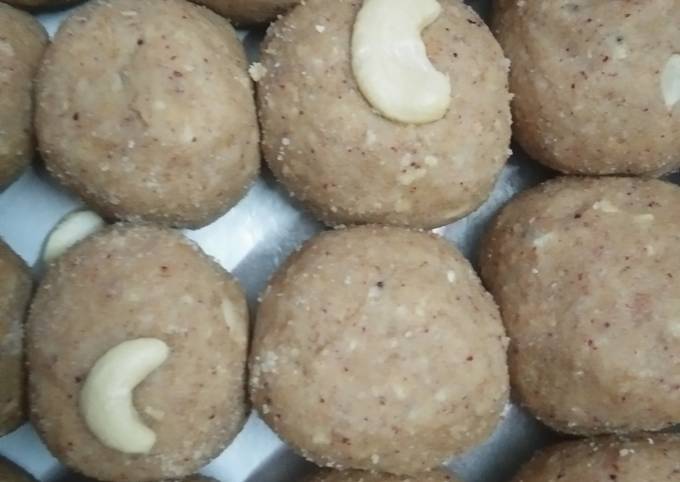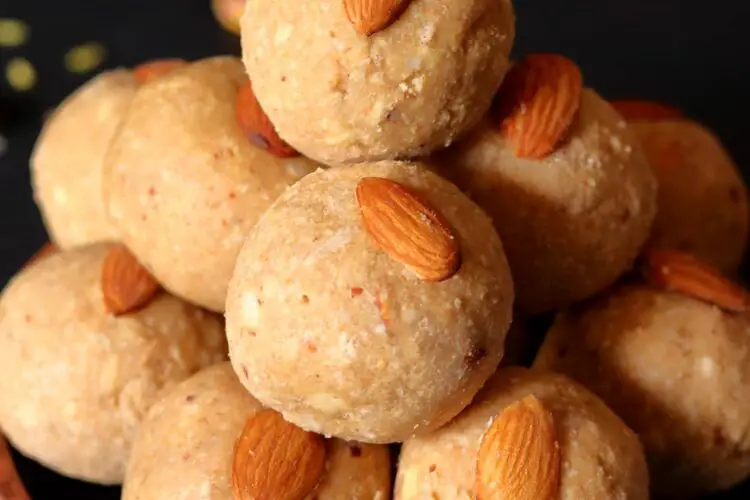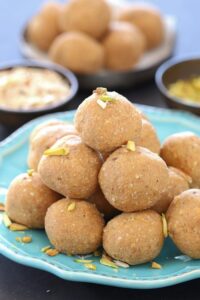Aate Ki Pinni is a mouthwatering sweet dish that is very well-liked in India’s northern states.
It is an easy and healthy Laddu recipe made with wheat flour, gond, sugar, and clarified butter. the dessert mainly hails from the north Indian cuisine, particularly from the Punjabi house but is widely accepted in India.
Aate Ki Pinni can be made for any festival celebration or occasion, but also as a snack or as a simple dessert after the meal. People with a sweet tooth will find this dessert recipe to be a great joy. Serve this wonderful dessert to your guests as a way to celebrate Baisakhi.

The gond particles in the wheat pinni laddu add to its flavor and make eating it a pleasant experience. Furthermore, I enjoy desserts that are tasty because they combine wheat and ghee. In other words, the only difference between this recipe and the panjiri is the shape of the balls.
Also, read this recipe
Health benefits of Aate Ki Pinni
- Rich in Fiber: Whole wheat flour used in Aate ki Pinni is a good source of dietary fiber. Fiber aids digestion promotes regular bowel movements, and helps in maintaining gut health.
- Energy Boost: Ghee, a primary ingredient in pinnis, is calorie-dense and provides a quick source of energy. It can be particularly beneficial for individuals needing an energy boost, such as athletes or those engaged in physically demanding activities.
- Nutrient-Rich: Aate ki Pinni often contains chopped nuts like almonds, cashews, and pistachios. These nuts are packed with essential nutrients, including healthy fats, protein, vitamins, and minerals, which contribute to overall health.
- Source of Healthy Fats: Ghee, while high in saturated fat, contains healthy fats like conjugated linoleic acid (CLA) and butyric acid, which have been linked to various health benefits, including improved heart health and reduced inflammation.
- Moderate Sugar Content: Aate ki Pinni typically includes a moderate amount of sugar. Consumed in moderation, it can satisfy sweet cravings without causing excessive sugar intake, which can be harmful to health.
- Protein: The combination of whole wheat flour and nuts provides a moderate amount of protein, which is essential for muscle repair, immune function, and overall growth and maintenance of the body.
Ingredients for Aate Ki Pinni
- 100 grams Gond / Edible Gum
- 250 grams of Whole Wheat Flour
- 250 grams of powdered Sugar
- 50 grams Cashew
- 150 gram Ghee
- 40 grams Pistachio
- 40 grams Almonds
- 10-gram makhana
- 25 grams Melon Seeds
- 1 teaspoon Cardamom Powder /Elaichi
- 2 tablespoon Ginger Powder
- ¼ tsp cardamom powder
Instructions for Aate Ki Pinni
- First, add 1/4 cup edible gum to 1/4 cup ghee in a pan (gond).
- Once the gond puffs up and turns crystal, roast over a low flame.
- Turn off the heat when the gond reaches a golden brown color and let it cool. The edible gum should then be ground into a coarse powder in a grinder.
- Grind the dry fruits after removing them and placing them in a basin. Crush the almonds, pistachios, and cashews in a grinder jar.
- Then, using the same pan, add extra ghee to it. Ghee should be heated before wheat flour is added.
- Reduce the heat, then toast the wheat flour until it turns golden brown and releases a nutty aroma.
- Keep continuously stirring the wheat flour to avoid over-cooking.
- Add powdered gond, crushed almonds, pistachio, cashew, and melon seeds to the well-roasted atta.
- The well-roasted atta should be combined with the gond powder, crushed almonds, pistachio, cashew, and melon seeds.
- All the ingredients should be thoroughly combined before cooling.
- Add castor sugar to the mixture once it has cooled just a bit. After thoroughly combining them, split out small amounts and roll each one into a ball form.
- Finally, when kept in an airtight container, aate ki pinni can be enjoyed for a month
Tips and Variations
Suji can also be added in addition to wheat flour to create a gritty texture.
To make ladoo nutritious and healthy, add a variety of dry fruits.
After the flour mixture has cooled, add the sugar. If you add sugar after the mixture has warmed up, the laddoo won’t hold its shape and will crack easily.
The wheat flour shouldn’t be overroasted since otherwise it would burn and taste unpleasant.
FAQs
Do you have room for Aate Ki Pinnis?
These pinnis do indeed have a long shelf life. When kept in an airtight container, they last for about a month at room temperature (or steel dabba).
How is vegan Aate Ki Pinni made?
Due to the large amount of ghee used, these pinnies are not vegan. Coconut oil can be used in place of ghee to make them vegan. Additionally, you can use coconut or grass-fed vegan ghee.
Can I make aata pinni without gluten?
Yes, you can surely make gluten-free chakki atta to create these pinnis without gluten (gluten-free wheat ki pinnis made without gluten is definitely possible. You can use gram flour or gluten flour).
Conclusion,
In conclusion, Aate ki Pinni is a delightful and traditional Indian sweet treat that brings comfort and warmth to any occasion. This simple yet flavorful dessert is made from whole wheat flour, ghee (clarified butter), and other ingredients like nuts, cardamom, and sugar. Aate ki Pinni not only satisfies the sweet tooth but also offers a dose of nostalgia and tradition.
The process of making Aate ki Pinni involves roasting the wheat flour to a golden brown, which imparts a rich, nutty flavor to the dish. Mixing in ghee, sugar, and aromatic spices like cardamom adds depth and sweetness. The addition of chopped nuts not only enhances the texture but also provides a delightful crunch.
Nutrition
| Calories | 174kcal |
| Fat | 9g |
| Fiber |
4g
|
| Iron |
1mg
|
| Carbohydrates | 23g |
| Protein | 2g |
| Vitamin A |
326IU
|
| Calcium |
10mg
|
You Might Also Like:
- Cinnamon Tea for Weight Loss
- chicken chatpata recipe
- Oreo Mug Cake Recipe
- Paneer Dum Biryani Recipe
- Aloo paneer paratha recipe


